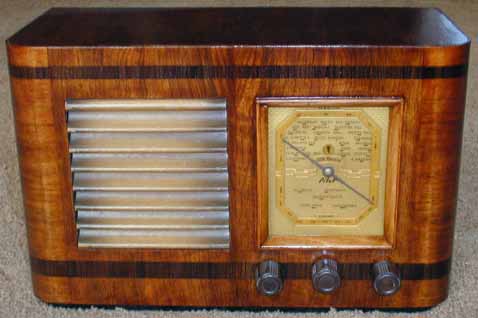
Pilot Little Maestro

This is one of my favourites! Found it at a car boot sale amongst a load of agricultural bits and pieces. Only cost me a fiver (haggled down from six quid!). It was in a bit of a state, mind you, and missing one of its knobs. The case was completely stripped down and re French polished (except for the wooden speaker grill - I rather like the "smoked edge" effect). Unbelievably (to me, anyway), I managed to find the exact replacement for the missing knob whilst scrabbling around in a cardboard box at the NEC one year!
The good thing about these midget radios (I think that's how they're referred to) is that they don't take up much room. This is important as I'm running out of space! I suppose it must have been quite daring in its day, from an engineering point of view. Considering the size of the valves plus IF cans, etc, it was obviously something of a challenge to pack it all into such a small space.
The downside, of course, was the voltage dropping arrangement. Certainly no room for a mains transformer - and a dropper resistor inside the case would have created an oven! So clearly a bit of lateral thinking was called for, resulting in the dreaded "line cord" dropper. I wonder how many fires were started by these being coiled up for tidiness. Or worse still, cut off and replaced with a normal flex!
Needless to say replacements are not readily available (even if you were mad enough to want to fit one). So what to do? The answer is that magic concept, the "watt-less" resistor - otherwise known as a capacitor! I'd toyed with the idea of this for some years but never taken it further as I assumed that suitable components would not be available. The solution, however, does exist - in the form of motor run capacitors. These are available in the right sort of values and, of course, are designed for a hard life. A useful design guide is available at
http://www.vintage-radio.com/restore/dropper.shtml The only difficulty is where to position such a component. Unlike in the Portadyne "midget" there was nowhere particularly obvious to put it so it is presently wedged in between the frequency changer and the 1st IF can. Not ideal - but it fits.Back to Radio Gallery